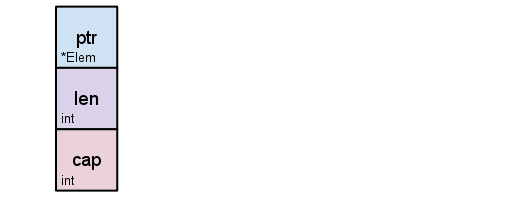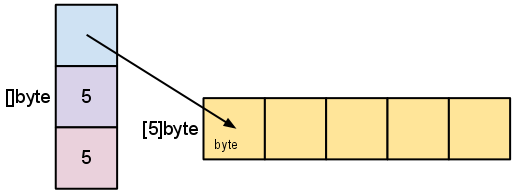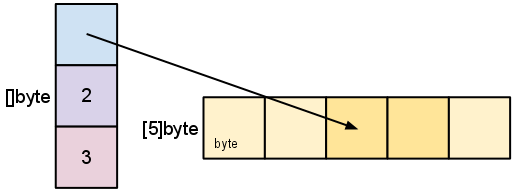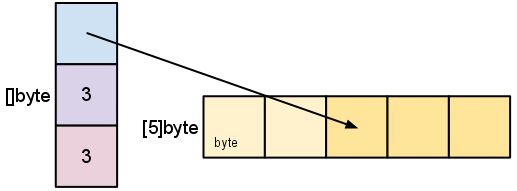1. 在学slice的时候有个地方感到困惑:
unc main() { s := []int{2, 3, 5, 7, 11, 13} printSlice(s) // Slice the slice to give it zero length. s = s[:0] printSlice(s) // Extend its length. s = s[:4] printSlice(s) s = s[:2] printSlice(s) s = s[:5] printSlice(s) // Drop its first two values. s = s[2:] printSlice(s) s = s[:5] printSlice(s) } func printSlice(s []int) { fmt.Printf("len=%d cap=%d %v ", len(s), cap(s), s) }
--------
len=6 cap=6 [2 3 5 7 11 13]
len=0 cap=6 []
len=4 cap=6 [2 3 5 7]
len=2 cap=6 [2 3]
len=5 cap=6 [2 3 5 7 11]
len=3 cap=4 [5 7 11]
panic: runtime error: slice bounds out of range [:5] with capacity 4
从运行结果看,当end indices小于最大索引5时(s = s[:0]),slice的capacity不变还是6,而且还可以加长,(s = s[:4]),但当start indices大于0时,(s = s[2:]),slice的capacity就变小了。
在https://go.dev/blog/slices-intro,这里介绍了slice的内部机制。
--------------->
Slice internals
A slice is a descriptor of an array segment. It consists of a pointer to the array, the length of the segment, and its capacity (the maximum length of the segment).

Our variable s, created earlier by make([]byte, 5), is structured like this:

The length is the number of elements referred to by the slice. The capacity is the number of elements in the underlying array (beginning at the element referred to by the slice pointer). The distinction between length and capacity will be made clear as we walk through the next few examples.
As we slice s, observe the changes in the slice data structure and their relation to the underlying array:
s = s[2:4]

Slicing does not copy the slice’s data. It creates a new slice value that points to the original array. This makes slice operations as efficient as manipulating array indices. Therefore, modifying the elements (not the slice itself) of a re-slice modifies the elements of the original slice:
d := []byte{'r', 'o', 'a', 'd'}
e := d[2:]
// e == []byte{'a', 'd'}
e[1] = 'm'
// e == []byte{'a', 'm'}
// d == []byte{'r', 'o', 'a', 'm'}
Earlier we sliced s to a length shorter than its capacity. We can grow s to its capacity by slicing it again:
s = s[:cap(s)]

A slice cannot be grown beyond its capacity. Attempting to do so will cause a runtime panic, just as when indexing outside the bounds of a slice or array. Similarly, slices cannot be re-sliced below zero to access earlier elements in the array.
------------------------->
从官方的文章可以看到这个原因是因为当start indices大于0时(s = s[2:4]),指针指向了index=2这个位置,The capacity is the number of elements in the underlying array (beginning at the element referred to by the slice pointer),所以capacity变小了。而上例当end indices小于最大索引5时,因为指针位置没变,所以capacity不变。
2. package的init()
在调用一个测试时发现会总是调另外一个package下面的init()方法
import ( "common/log" card2 "common/serverComm/card" "subGame/zjh/card" "subGame/zjh/msg" "testing" ) func TestCalculateCardsScore(t *testing.T) { cardInfo :=&msg.TableCardInfo{} c1 := &card2.Card{Num:2,Color:1} c2 := &card2.Card{Num:1,Color:1} c3 := &card2.Card{Num:1,Color:2} cards := []*card2.Card{c1,c2,c3} cardInfo.Cards = cards card.CalculateCardsScore(cardInfo) log.Info("card typs is %v",cardInfo.CardType) log.Info("card1.num=%v,card1.color%v",cards[0].Num,cards[0].Color) log.Info("card2.num=%v,card2.color%v",cards[1].Num,cards[1].Color) log.Info("card3.num=%v,card3.color%v",cards[2].Num,cards[2].Color) }
这个的包是room->internal->logic
但是会调到conf->下面的json.go的init方法,测过就算不import任何包,init方法总是会被调到。conf和room属于同一个module。